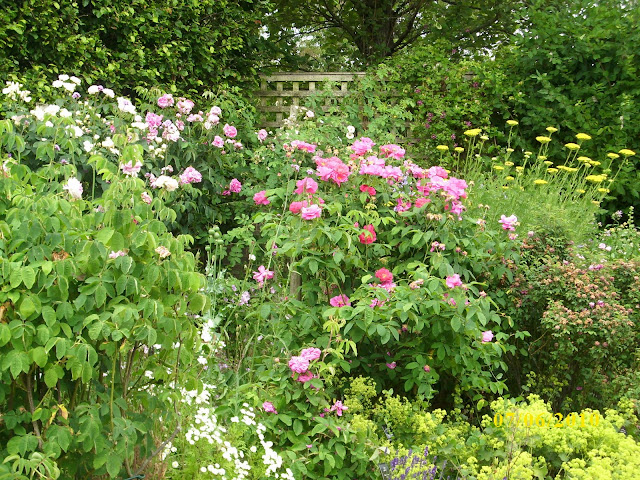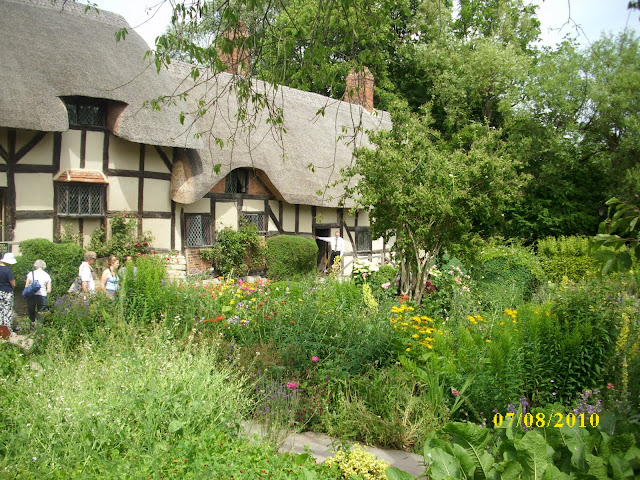Flower from the garden decorated each window in Jane Austen's house.
Jane Austen's House
After her father died, Jane, her sister Cassandra, and their mother faced quite a few years of financial hardship. The family house and land was entailed away to Mr. Austen's extended family. The Austen sons were young men and only starting out in the world. Both Cassandra and Jane had been disappointed in love and had no prospects or desire for marriage. The women got by with difficulty on the money Jane made from her writing and the small amounts their brothers managed to send. Fortunately for everyone, one of the Austens' distant relatives died and because of the laws of entailment, James Austen inherited the estate in Chawton. He was able to give a pleasant, village home to his sisters and mother and provide for them. In letters that Jane wrote to the family, she expressed her great relief, but also her joy that the house had room for a small garden with good sun exposure. The garden was informal and lighthearted. Just right!

 |
This the flower border next to the stone wall. The street marker
at the top of the picture is typical of the signs in villages.
I wish I could grow hollyhocks like this!
Look at those colors.
These gems were so bright that they were almost florescent.
I'm not sure, but I think those seed pods are poppies.
English roses!!!
William Shakespeare's Birthplace
What we call Tudor style houses, the British call Black and White houses. Over the years, the timber was usually painted black to preserve it, and the stucco was usually white washed. Shakespeare's birthplace was restored to the appearance it probably had during Bill's lifetime.

Shakespeare probably didn't do much gardening. After all, he was a very industrious entrepreneur. He saw himself as a businessman first and foremost and never set out to be a "great artist." I think he would be astounded that today people think of him as snooty and highbrow! But it's clear from his plays and poetry that ol' Bill knew a thing or two about plants and flowers.

The steeple of Trinity Church from the River Avon. Growing up in such a beautiful place must have an effect on the person.
Long boats on the River Avon
The recently discovered Cobble painting of William Shakespeare.
It was the only portrait made of Shakespeare during his life.
All of the other paintings, the ones that we grew up with,
were created from people's memory of Bill's appearance.
Anne Hathaway's Cottage
William courted his wife, Anne Hathaway, at her family's home in Shottery outside of Stratford. The house stayed in the family until the early 1900's when the last member of the family sold the house to the Shakespeare Birthplace Trust on the condition that she could continue to live in the home as the caretaker for the rest of her life. The flower garden sits down in a tiny valley behind the house. Whether the valley is natural or man made, it provides wonderful drainage for the flowers. You can see that they are very happy!
The gardener told me they were suffering from a draught!
I couldn't believe the height of the flowers!
Ah! The sweet peas were heavenly.
After Anne Hathaway's Cottage, the bus took us 7 miles out of Stratford to Mary Arden's Farm in the village of Wilmcote. The scenery was breathtaking. The Cotswold is one of the most beautiful places I've ever been!
Little bits of beauty dusted the countryside.
|
Mary Arden's Farm
Bill got his business ability from his mother's side of the family. The Ardens were a prosperous family and the father was considered a gentleman farmer. That meant he owned and lived at the farm, but employed hired hands to do all the work. The Arden farm continued to be a working enterprise until the 1900's when the Shakespeare Birthplace Trust bought it. The farm and the tiny village of Shottery were so very English!
The Wilmcote village pub. Every village is required to have one!
The farm is now a living history museum. The employees
dress in period costumes and use farming techniques
from Tudor times. The pigs were odiforous, but adorable.






















No comments:
Post a Comment